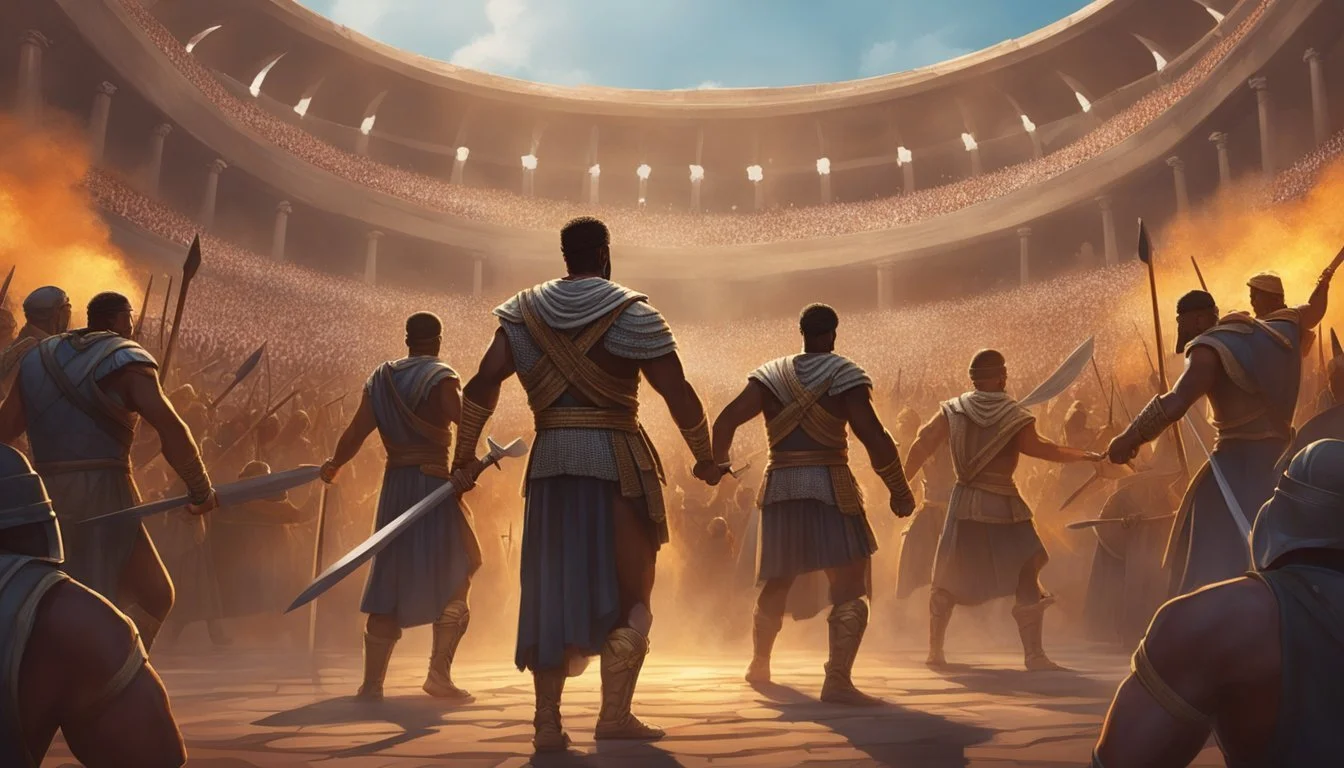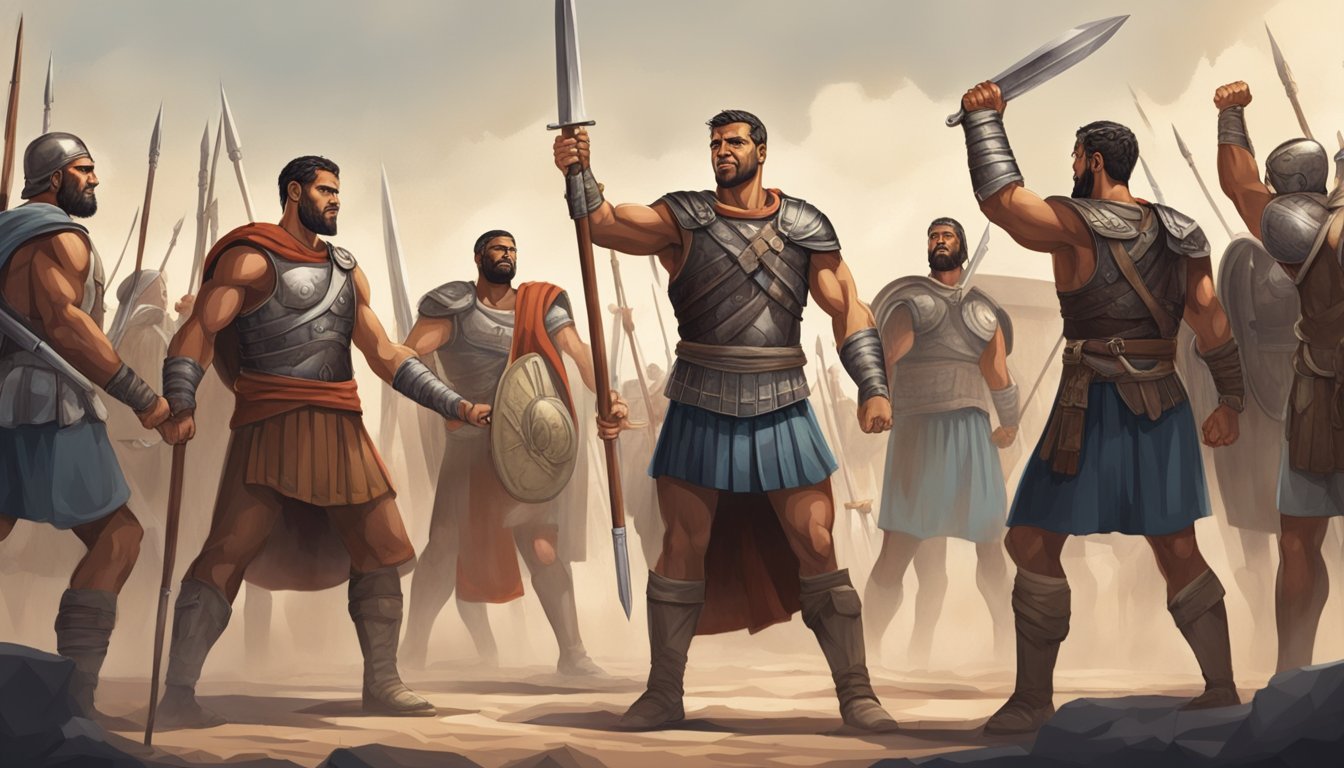The Real Spartacus: Slave Rebellion vs. Hollywood Epic
Separating Fact from Fiction in Ancient Rome's Most Famous Uprising
Spartacus, the legendary gladiator who led a slave rebellion against the Roman Republic, has captivated imaginations for centuries. His story has been immortalized in film and television, most notably in Stanley Kubrick's 1960 epic starring Kirk Douglas. While the Hollywood version takes creative liberties, it captures the essence of Spartacus's struggle and the brutality of Roman slavery.
The real Spartacus was a Thracian slave who became a skilled gladiator in the school of Batiatus. Historical sources confirm the harsh treatment of slaves depicted in the film. Spartacus's rebellion, known as the Third Servile War, began in 73 BCE and lasted two years. He led an army of escaped slaves and gladiators that posed a significant threat to Rome.
The film's portrayal of Spartacus's origins and rise to prominence is largely accurate. However, some details diverge from historical records. For instance, the real Spartacus died in battle rather than being crucified as shown in the movie. Despite these differences, Kubrick's "Spartacus" remains a powerful representation of one of history's most famous uprisings against oppression.
Historical Context of Spartacus
Spartacus emerged as a pivotal figure during a tumultuous period in Roman history. His rebellion exposed deep societal tensions and challenged the established order of the Roman Republic.
Roman Society and the Position of Slaves
Roman society in the 1st century BCE was highly stratified. A small elite held most of the wealth and power. Slaves formed a significant portion of the population, estimated at 30-40% in some areas. They were considered property, not people, under Roman law.
Slaves performed various roles. Some worked as domestic servants or skilled craftsmen. Others toiled in harsh conditions on large estates or in mines. Gladiators like Spartacus occupied a unique position. They faced brutal conditions but could gain fame and, occasionally, freedom.
The treatment of slaves varied widely. Some experienced relative comfort, while others endured severe abuse. This disparity contributed to growing unrest among the slave population.
The Third Servile War
The Third Servile War, also known as the Gladiator War, erupted in 73 BCE. It began when Spartacus and about 70 fellow gladiators escaped from a training school in Capua.
The rebels' initial success attracted thousands more slaves. Their army grew to an estimated 120,000 at its peak. For two years, they defeated several Roman forces sent against them.
The rebellion spread fear throughout Italy. It threatened Rome's economic system and social order. The Senate eventually tasked Marcus Licinius Crassus, a wealthy general, with suppressing the revolt.
After a series of battles, Crassus cornered and defeated Spartacus in 71 BCE. The aftermath was brutal. Thousands of captured slaves were crucified along the Appian Way as a warning against future rebellions.
The Real Spartacus
Spartacus, a Thracian gladiator, led one of the most significant slave rebellions against the Roman Republic. His life and actions shaped history, challenging the mighty Roman empire and inspiring generations to come.
Early Life and Enslavement
Born in Thrace around 109 BCE, Spartacus likely served in the Roman auxiliary forces. He deserted the army and was later captured and sold into slavery. As punishment, he was forced to become a gladiator in Capua.
Gladiatorial schools were brutal places, designed to train men for violent spectacles. Spartacus honed his combat skills here, preparing for the arena. These experiences shaped his future as a military leader.
In 73 BCE, Spartacus and about 70 fellow gladiators staged a daring escape. They seized weapons from the kitchen and fought their way out of the school. This marked the beginning of the Third Servile War.
Leadership in the Slave Revolt
Spartacus quickly proved himself a capable leader. He and his fellow escapees took refuge on Mount Vesuvius, where more runaway slaves joined them.
His charisma and strategic mind attracted thousands of followers. The rebel army grew to include men, women, and children from various backgrounds.
Spartacus advocated for equal distribution of plunder and fair treatment of all rebels. This egalitarian approach strengthened loyalty within his ranks.
He also showed mercy to captured Romans, often offering them the choice to join or leave unharmed. This contrasted sharply with typical Roman practices.
Strategies and Military Engagements
Spartacus employed guerrilla tactics, using the terrain to his advantage. He avoided pitched battles when possible, preferring hit-and-run attacks.
The rebels defeated several Roman forces sent against them. In 73 BCE, they repelled an attack by Gaius Claudius Glaber, who had besieged them on Vesuvius.
Spartacus led his army across Italy, winning numerous victories. They defeated consular armies and even considered marching on Rome itself.
His most ambitious plan involved crossing the Alps to escape Italy. However, his army, wanting revenge and plunder, convinced him to turn back south.
Spartacus' Legacy and Death
In 71 BCE, Marcus Licinius Crassus finally defeated Spartacus in a decisive battle. Spartacus likely died fighting, though his body was never found.
The rebellion's suppression saw 6,000 captured slaves crucified along the Appian Way. This brutal act demonstrated Rome's determination to prevent future uprisings.
Spartacus' legacy endured long after his death. He became a symbol of resistance against oppression and the fight for freedom.
His story has inspired countless works of art, literature, and film. The 1960 movie "Spartacus" and recent TV series have kept his legend alive in popular culture.
The Hollywood Epic: 'Spartacus' (1960)
Stanley Kubrick's 'Spartacus' brought the ancient slave rebellion to life on the big screen in 1960. The film starred Kirk Douglas and featured a star-studded cast, becoming a box office success and cultural phenomenon.
Development and Production
'Spartacus' began as a passion project for Kirk Douglas, who acquired the rights to Howard Fast's novel. Douglas hired Dalton Trumbo, a blacklisted screenwriter, to adapt the book. This decision helped break the Hollywood blacklist.
Initially, Anthony Mann directed the film. However, Douglas replaced him with Stanley Kubrick two weeks into production. Kubrick, only 31 at the time, took on the challenge of directing his first big-budget epic.
The film's production was ambitious, with a budget of $12 million - a substantial sum for its time. Filming took place in Spain and Hollywood, employing thousands of extras for large-scale battle scenes.
Plot Overview and Comparison with Historical Facts
'Spartacus' follows the titular character's journey from slave to gladiator to rebel leader. The film depicts Spartacus leading a slave revolt against the Roman Republic, known historically as the Third Servile War.
While the movie captures the essence of Spartacus' rebellion, it takes liberties with historical details. The film portrays Spartacus as a Thracian slave, which aligns with historical accounts. However, it romanticizes his relationship with Varinia and embellishes certain battle sequences.
The famous "I'm Spartacus" scene, where slaves protect their leader's identity, is a Hollywood invention. Yet, it powerfully conveys the solidarity among the rebels.
Cast and Characters
Kirk Douglas delivered a commanding performance as Spartacus, bringing depth to the character. Laurence Olivier portrayed Marcus Licinius Crassus, the Roman general opposing Spartacus. Their on-screen rivalry added tension to the narrative.
Other notable cast members included:
Jean Simmons as Varinia, Spartacus' love interest
Peter Ustinov as Batiatus, a slave trader
Charles Laughton as Gracchus, a Roman senator
Ustinov and Laughton's performances provided moments of levity, balancing the film's serious themes. Ustinov won an Academy Award for Best Supporting Actor for his role.
Cultural Impact and Critical Reception
'Spartacus' was a commercial success, grossing over $60 million worldwide. It received critical acclaim and won four Academy Awards, including Best Cinematography and Best Art Direction.
The film's themes of freedom and justice resonated with audiences. Its portrayal of slavery and rebellion sparked discussions about civil rights and social inequality.
'Spartacus' influenced subsequent historical epics and sword-and-sandal films. Its famous "I'm Spartacus" scene has been referenced and parodied numerous times in popular culture.
The film's legacy extends beyond entertainment. By crediting Dalton Trumbo, it played a significant role in ending the Hollywood blacklist, marking a turning point in American cinema history.
Impact on Modern Media and Culture
The story of Spartacus has captivated audiences for generations, inspiring numerous retellings across various media. His rebellion against Roman oppression has become a powerful symbol of resistance and the fight for freedom.
Reinterpretations in Film and Literature
Stanley Kubrick's 1960 film "Spartacus" starring Kirk Douglas brought the slave rebel's story to mainstream audiences. The movie's famous "I am Spartacus" scene became an iconic cultural moment.
Numerous books have reimagined Spartacus's tale, including Howard Fast's 1951 novel that inspired Kubrick's film. More recent works like Colleen McCullough's "The Grass Crown" offer nuanced portrayals of the historical figure.
Television adaptations like the Starz series "Spartacus" (2010-2013) have presented grittier, more violent versions of the story. These modern retellings often emphasize themes of social injustice and revolution.
Spartacus as a Symbol of Resistance
Spartacus's rebellion has become a powerful metaphor for fighting oppression and injustice. Labor movements and civil rights activists have invoked his name as a rallying cry.
The Spartacus League, a Marxist revolutionary movement in early 20th century Germany, took inspiration from the slave revolt. Political groups and sports teams have adopted the name "Spartacus" to evoke ideas of strength and defiance.
In popular culture, Spartacus is often portrayed as a heroic underdog fighting against tyranny. This image, while not entirely historically accurate, resonates with modern audiences and their ideals of freedom and equality.
Historiography of Spartacus
Ancient and modern historians have grappled with reconstructing the life and rebellion of Spartacus. Their efforts have shaped our understanding of this enigmatic figure and his impact on Roman society.
Ancient Sources on Spartacus
Plutarch and Appian provide the most detailed accounts of Spartacus. These Greek historians, writing over a century after the events, relied on earlier Roman sources now lost to us.
Plutarch portrays Spartacus as a charismatic leader of noble character. He emphasizes the gladiator's intelligence and fairness.
Appian offers a more military-focused narrative. He details the tactics and battles of the slave rebellion.
Other ancient writers like Sallust, Livy, and Florus mention Spartacus briefly. Their fragmentary accounts add some details but often conflict with each other.
Modern Historical Analysis
Contemporary historians approach Spartacus with critical scrutiny. They compare ancient sources, analyze archaeological evidence, and consider the socio-economic context of the Roman Republic.
Barry Strauss's "The Spartacus War" (2009) synthesizes current scholarship. It presents Spartacus as a skilled military leader navigating complex political realities.
Brent Shaw's work examines the slave revolt within the broader context of Roman labor practices and resistance movements.
Debates continue over Spartacus's motivations and goals. Some argue he sought to overthrow slavery, while others see him as primarily seeking personal freedom.
Concluding Remarks
The story of Spartacus continues to captivate audiences, bridging the gap between historical fact and cinematic fiction. Stanley Kubrick's 1960 film adaptation brought this ancient tale to life for modern viewers.
While taking creative liberties, the movie succeeded in conveying the essence of Spartacus's struggle against oppression. It highlighted themes of freedom, justice, and human dignity that resonated with 1960s American audiences.
The real Spartacus led a significant slave rebellion that shook the Roman Republic. His actions, though ultimately unsuccessful, left a lasting impact on history and continue to inspire.
Hollywood's portrayal, particularly Kirk Douglas's iconic performance, cemented Spartacus as a symbol of resistance against tyranny. The film's dramatic narrative choices served to amplify the emotional impact of the story.
By examining both the historical record and cinematic interpretation, we gain a richer understanding of Spartacus's legacy. His story reminds us of the enduring human spirit in the face of adversity.
The blending of fact and fiction in "Spartacus" demonstrates the power of cinema to bring historical figures to life. It serves as a compelling example of how ancient tales can be reimagined for contemporary audiences.







